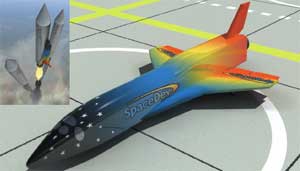US firm SpaceDev has designed a passenger vehicle for low-orbital and orbital flights for NASA, in the latest step towards commercial space travel.
In a study for the space agency, the California-based company has designed the Dream Chaser, a sixpassenger concept vehicle that would use scaled-up versions of the non-explosive hybrid rocket motors used in last year’s X Prizewinning SpaceShipOne.
The company said the spacecraft could be used for manned low-orbital missions by 2008. The Dream Chaser’s hybrid propulsion system burns rubber and nitrous oxide, or laughing gas. The 15m-long craft will be able to fly to altitudes of about 100 miles, with SpaceDev’s hybrid rocket motor providing approximately six times the thrust of the motors on SpaceShipOne.
It is expected to debut as a reusable piloted sub-orbital ship in initial tests. However, in the future it could be used to dock with the International Space Station or even a commercial space hotel orbiting Earth. For orbital travel the Dream Chaser would be fitted with even larger versions of the hybrid boosters.
Chief executive and founder of SpaceDev Jim Benson said: ‘Being able to reach and then dock with the ISS is our minimum requirement for this project. If we can reach that then we should be able to get to many other destinations in loworbit including crew exploration vehicles or commercial enterprises.

‘By combining existing technologies and designs in a unique and innovative manner, we believe we can reduce the risk, cost and time to market for commercially viable human space transport,’ he said.
SpaceDev signed a contract last year with NASA’s Ames Research Centre in northern California to develop the hi-tech passenger spacecraft and was granted access to the agency’s prototype vehicles to design and test its data. The design for the reusable craft itself is partly based on versions of NASA’s own prototype hypersonic vehicles.
SpaceDev researchers worked with NASA engineers to develop a viable thermal protection design for the spacecraft’s re-entry into Earth’s atmosphere. They analysed re-entry trajectory data and found that the nose-cone and wingtips had to be rounded to survive the heat of re-entry.
Following low-orbit space flights in 2008, the company hopes to send the vehicle into orbit for the first time by 2010.
Benson estimates that the Dream Chaser will cost $100–200m (£55m–£110m) to develop.




Poll: Should the UK’s railways be renationalised?
The term innovation is bandied about in relation to rail almost as a mantra. Everything has to be innovative. There is precious little evidence of...